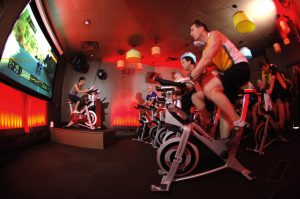One of the most challenging things about teaching an indoor cycling class to a general population is asking them to hold a steady-state effort for longer periods, such as 6, 7, or 8 minutes or more.
Why is it so challenging?
Steady state implies a sustainable, moderate effort level below threshold; something you can do for a longer period of time without requiring a recovery. It doesn’t hurt, it doesn’t sting the legs or lungs, and it doesn’t leave you breathless.
It may feel like you are holding back. That’s a common feeling among the riders I have coached (remember, we are talking power-based coaching so we have something to measure) and it’s an interesting observation. The idea that you can—and sometimes must—hold back.
The problem is that some may interpret that to mean you are not getting a workout, and thus, not getting more fit.
But this is the furthest thing from the truth. There are many positive physiological adaptations at this level of intensity that take place, leading to improved aerobic fitness.
In so many other group fitness classes, attendees are coached to (and expected to) max out, or at least to go very hard. Since our riders may hear in these classes statements like, “You can work harder!” one can understand that they might question why they are not doing that in the cycling class.
While high intensity in itself isn’t a bad thing, doing it every time you go to the gym, every time you work out, doesn’t always advance your fitness and may, in fact, suppress advances in fitness if you do it too often.
Is indoor cycling meant to be really hard all the time? The general consensus is that is how the general public views a cycling class. This is predominantly based on what they read in magazines and online, and what they see in a gym or studio as attendees come out dripping in sweat, grimacing, and mentioning how much of a “butt-kicking” the class was.
Sure, there is a time to NOT hold back and to push yourself. There is a time to work harder than you usually do. There is a place for leaving nothing on the table. However, high-intensity workouts should be part of a larger program, a structure.
Which brings me back to steady-state efforts. What is so great about steady-state workouts? For me, it is primarily what it teaches you about yourself.

In addition to educating riders that wringing themselves out every time is not always necessary, training with longer steady-state efforts helps to improve their confidence. If riders can build on their ability to be slightly uncomfortable for longer periods at aerobic efforts, they will soon be able to see and feel the results.
Comfort in ability breeds confidence. Confidence leads to improvement. Instead of stressing out about the longer efforts, riders will relax. If a rider is relaxed, they will produce a smooth and consistent pedal stroke, which leads to a more homogenous power output. In other words, they will become more steady and less prone to fluctuations.
By becoming used to holding a steady effort, riders will feel more comfortable when tackling a more challenging effort at a higher power level, and their ability to remain in control will assist them at these higher levels. They will feel more able to maintain form, the confidence to do so coming from their previous work at lower power levels.
Those longer efforts on the edge of one’s abilities are where the threshold of confidence lies, and it’s there that we test the combination of newly discovered patience, technique, and self-belief.
If riders don’t build up an ability to ride for longer periods at a steady-state level, their fitness improvements will be limited. For a coach, this is where the gold is to be found: the act of transferring belief from coach to rider.
Essentially, as soon as they’ve been taken through an FTP test, riders should be educated about the importance of the sustainable level of Zone 3 (known as “tempo”) and be encouraged to get comfortable there. They will soon discover that it’s not just physical gains that are awaiting them—there are substantial mental gains. It is the mind that most often causes riders to back off or quit; this improved mental strength will help them in many areas of their fitness goals.
How many times have you seen a rider push themselves beyond their self-imposed limitations because you coached them with strong, inspiring, and powerful cues? It’s a very rewarding feeling, isn’t it?
This is so much easier to do if riders have already built up a previous history of longer steady-state efforts that have been developed progressively over time. Their ability to hold a steady, relaxed pace with smooth and controlled power will take them to new heights in their fitness.
The takeaway is this: don’t be wary of longer, steady-state efforts because you think your riders won’t accept them. Let your participants discover the strength of mind and body that comes as a consequence of these efforts. Show them that by developing this most essential groundwork in their fitness, they are more capable than they believe themselves to be. You can transfer that belief from you, the coach, to them, the rider.
Note: ICA has additional articles on this topic, including a four-part series on how to incorporate longer intervals and four profiles using steady-state longer intervals:
How to Incorporate Long Intervals, Part 1: Why Long Intervals Are Important
How to Incorporate Long Intervals, Part 2: Preparing for a 20-Minute FTP Assessment
How to Incorporate Long Intervals, Part 3: Progressive Programming Over Six Weeks
How to Incorporate Long Intervals, Part 4: Music for Longer Intervals
Class Profile: Longer Cruise Intervals (Izabela Ruprick)
Class Profile: That Sweet Spot (Julianne Lafleur)
Class Profile: The Sweetest Sweet Spot (Jennifer Sage) (Theme ride using songs with “sweet” in them.)
Class Profile: The Delicious Ride (Jennifer Sage)
Class Profile: Reverie—Aerobic Intervals (Jennifer Sage) (Focuses on the mental side of aerobic work.)


Thank you! Love this! I love teaching Tempo and our peeps LOVE it. Our PWR team constantly educates them on why we do this and the importance and benefits of working at this effort. Actually Tempo are my favorite rides to do myself. I call it my Yummy Ride! Thanks again for everything you do. I love everything about these articles, profiles, music etc. The BEST!!!!
Thank you so much for this! So many great phrases and cues to use! I do a lot of long SS efforts at sweet spot/threshold, but I find myself running out of cues & imagery. ‘Threshold of confidence‘ might be my new favorite!
Hey…you are very welcome! Glad you like it.
A great team collaboration to get the article just right.
Steve